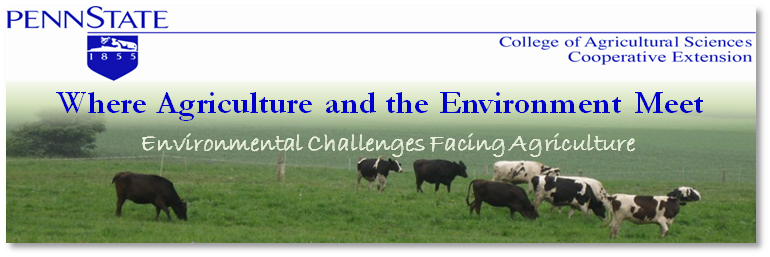 |
| Festive Cow to Bring a Smile to Your Face |
December 21, 2010
Another Year Comes to an End
December 13, 2010
Pennsylvania Watershed Implementation Plan: Impacts on Dairy Farming
Environmental regulations are moving fast and furious and it can be hard to keep up, but all dairy farms in the Chesapeake Bay Watershed will be affected so understanding these new regulations is a must. The final Total Maximum Daily Load (TMDL), or “pollution diet”, will be out by December 31st and will outline the official and final rules going forward. Because the final TMDL is not out yet this article will focus on the preliminary TMDL and Pennsylvania’s final Watershed Implementation Plan (WIP). The final TMDL will reflect the WIPs submitted by each state in the watershed unless EPA (Environmental Protection Agency) thinks that the state WIPs will not meet water quality goals then EPA will override the state plans with their own regulations.
The Pennsylvania WIP focuses on increasing enforcement of current laws. The PA Clean Streams law requires that all farms, regardless of size, control sediment and nutrient discharges from their farm, which includes from fields, silage and manure storage, milk house, barnyards, and animal concentration areas. To this end, all farms that disturb more than 5,000 square feet of land are required to have an erosion and sediment control plan (E&S plan), which is similar to a conservation plan. These plans do not need to be approved at the state or county level, but do need to be on the farm. As of November 19, 2010 this regulation was changed to include “animal heavy use” areas, require additional BMPs (best management practices) for fields within 100 feet of a stream, require that soil erosion be reduced to the highest amount that can be tolerated and still maintain sustainable crop productivity indefinitely (T), and require an implementation schedule.
The Pennsylvania WIP also relies on updates to the Manure Management Manual, which will be completed by spring 2011. The contents of this manual apply to all farms that have animals. At minimum, farms are required to have a manure management plan that covers collection, storage, and application of manure on fields. Specifically, it will address overall manure application, winter application, stockpiling manure, manure storage, pasture management, and animal heavy use areas. The Manure Management Manual will also require farms to apply manure at rates that will minimize phosphorus runoff, unless they can show that the risk is extremely low, such as with soil testing and the P-Index, a tool to determine the potential loss of phosphorus from the soil to waterways by looking at a variety of factors.
Farms with greater than 700 dairy cows (milking and dry), or CAOs with greater than 300 cows, are considered CAFOs (concentrated animal feeding operations) by the federal government and the state of Pennsylvania. CAFOs are required to adhere to even stricter laws than CAOs. Small farms can be deemed a CAFO by EPA if there is a point-source discharge from that farm into a local waterway, which could be something as simple a point leak in a barnyard where material from the barnyard can escape to a local waterway. The rules that apply to CAFOs may become stricter and it is possible that CAFO rules could be expanded to cover more farms if EPA does not determine that the Pennsylvania plan is sufficient to meet water quality goals.
Labels:
Water regulations
Subscribe to:
Posts (Atom)
